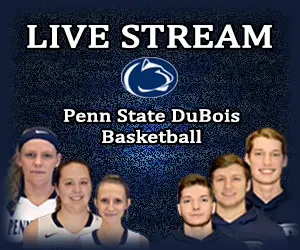
CLARION, Pa. (EYT/D9) — Jameson McIlwain jumped in the air to attempt a header.
When he landed, his left knee buckled. He crumpled to the turf soccer pitch at Karns City High School, knee throbbing, a million thoughts zipping through his mind.
He had never suffered a serious injury before. He feared this was one.
“I heard a couple of pops,” McIlwain said. “I couldn’t put any weight on it. I tried to get up right away, and I couldn’t. I just kind of sat there and was like, ‘What do I do? What am I supposed to do?’”
Little did the sophomore at Clarion Area High School, who plays for the Clarion-Limestone soccer team, know at the time, that harrowing moment would be the beginning of a history-making odyssey of science and perseverance.
The days after progressed like any of the thousands of other athletes who have suffered knee injuries. The initial prognosis was encouraging: a sprained MCL.
Some rest, a lot of ice and some good old fashioned TLC and McIlwain would be back striking the soccer ball in no time.
But the then 15-year-old — McIlwain turned 16 on Dec. 10 — felt deep down something far more serious was wrong with his painful left knee.

(Jameson McIlwain, a sophomore at Clarion Area High School who plays for the Clarion-Limestone soccer team, was hurt on Sept. 13 at Karns City, beginning journey that included a cutting edge ACL surgery)
He tried to power through the injury, participating as much as he could at practice.
He was told to rest again for a week. He did that and tweaked it again. He was told to take an even longer respite, this time two weeks, but the knee was still not right.
Physical therapy followed. Still no improvement.
All the while, the McIlwain family battled with their insurance company to approve an MRI.
Finally, another doctor was able to order the much-needed test nearly two months after McIwain’s injury. It revealed the damage to his knee was far more serious than an MCL sprain.
He had ruptured his ACL. A complete tear.
McIlwain suddenly had to come to grips with the cold reality of his situation. He was looking at surgery and then eight to 10 months of arduous rehab before he could even hope to be cleared again to play sports.
His spring club soccer season with the Clarion River Valley Strikers was gone. So, too, was his high school basketball season at Clarion-Limestone.
Jameson felt that sting and despair profoundly.
But then fate intervened.
McIlwain was referred to Dr. Matthew Varacallo, medical director of Orthopedic Robotic Surgery at Penn Highlands Healthcare in DuBois, for his surgery.
The family had no idea at the time that Dr. Varacallo was a pioneer of an innovative Fertilized ACL surgical technique.
The procedure involves extracting marrow from the tibia, a bone in the lower leg that contains a wealth of growth hormone and stem cells.
After the marrow is spun down into a concentrate, it is mixed with bone graft. Small tunnels are then made in the femur and tibia to place the graft during the surgery. The bone graft mixture and stem cells/growth factors are then injected into those tunnels to stimulate them. The tendon, which is used to repair or replace the ACL, transforms into a ligament faster and the tunnels bore into the bone heal more quickly.
The results have been striking.
“This is truly a cutting edge procedure,” Dr. Varacallo said in a release posted on Feb. 4 on the Penn Highlands Healthcare website. “In traditional ACL surgeries, the pressurized tunnels can be risk factors for re-injury because they can take up to six or seven months to heal. However, with the Fertilized ACL procedure, the tunnels heal faster because the graft starts to incorporate into the body faster. In fact, four weeks post surgery, you cannot even see the bone tunnels.”
Still, McIlwain and his family took the cautious approach.
They couldn’t quite believe the claims and they didn’t want to get their hopes up.
“(Dr. Varacallo) told us, ‘Hey, just so you know, I’m doing this new procedure where I take the bone marrow out of his leg and then re-inject it into his knee and we’re finding good results,’” said Jameson’s mother, Trish McIlwain. “I was like, ‘Oh, OK. Thank you. What kind of good results? Six to eight months?’”
Try as little as four.
Jameson and his family were in disbelief.
It wasn’t an easy process, though.
Jameson had to strengthen his left leg and knee before the surgery through physical therapy. The surgery itself was just as invasive as a typical ACL reconstruction and had the same pitfalls.
But Jameson cleared every hurdle rather well.
“I didn’t have a lot of pain,” Jameson said. “But it was definitely hard to get around for the first few weeks. I didn’t have a wheelchair, so I used my computer desk chair to get around the house.”
As the days and weeks passed, Jameson felt stronger. He was doing things in weeks that it usually takes other athletes who have gone under the knife months to achieve.
His recovery even exceeded Dr. Varacallo’s expectations.
Jameson was fully cleared on March 10 — just three months and seven days after his surgery.
“He’s never cleared an athlete as early as Jameson,” Trish said. “He sent Jameson’s numbers off to Marshall University — that’s the only other place that’s doing this surgery — and he surpassed the athletes that had the surgery there.”
Jameson was shocked and thrilled that he had recovered and been cleared so quickly.
“I was just amazed,” he said. “I was planning on just coming back in the fall. As soon as the doctor told me I could be cleared in four months, I was like, ‘Oh, maybe I can come back for the spring soccer season and play for the Strikers. Even being cleared in three months amazed me.”

A lot of the credit for Jameson’s speedy return goes to him.
“Even the doctor said, all the praise goes to Jameson for putting in the hard work,” Trish said. “He was doing three days of physical therapy. He was working with our school athletic trainer five days a week. He wanted really badly to play basketball.”
He didn’t quite make it back in time for that, although he made it a point to try to be at every Clarion basketball practice and attend every game during his recovery.
When he was cleared to play soccer again, his club coaches with the Strikers were amazed.
They coined a new nickname for Jameson.
“Miracle Man.”
“They just can’t believe it,” Jameson said. “I know how they feel.”
The brace he wears is nothing like the bulky contraptions most athletes recovering from ACL surgery must wear. It’s just a supportive sleeve and even that he can shed soon.
He’s not required to wear it as a sprinter on the Clarion Area track and field team this spring in a co-op with North Clarion.
Jameson almost feels 100%. His speed — such a weapon for him on the soccer pitch — has returned. The thing he struggled with the most was the mental aspect of his rapid recovery.
Like most players who suffer major knee injuries, there’s always that fear lurking in the back of his mind that it could happen again.
“The doctor said there is a mental part of this,” Trish said. “He said any athlete goes through it and I would hope he would have it.”
Jameson, though, trusted his knee. He was in tune with what it felt like. He was cognizant of when it was feeling strong and when it was time to back off — just a bit.
“They’re actually worried about my right leg, injuring that one, because my left leg is already stronger than my right,” he said.
Rehab was also a challenge. This was uncharted territory.
Jameson was ready to do things at six weeks that most athletes can’t do after surgery for several months.
Samantha Morgan, a certified athletic trainer with Penn Highlands Healthcare as well as at Clearfield Area High School, also helped Jameson with his recovery. She got him the proper protocols in rehab to help speed up his healing time.
“Rehab was boring for him,” Trish said. “Sam said, ‘You know, he needs to be leaving physical therapy exhausted. It needs to be a real workout.’ She was able to get him on the right protocols.”
“I slept really well at night after that,” Jameson added.
This experience has taught Jameson a great deal about himself, what his limits are, both physically and mentally.
Above all, he is thankful.
Grateful this new surgical technique was able to get him back on the field in a fraction of the time it usually takes for an athlete to return.
Jameson now knows anything is possible.
‘
“If you set your mind on a goal,” Jameson said. “You can do it.”

















